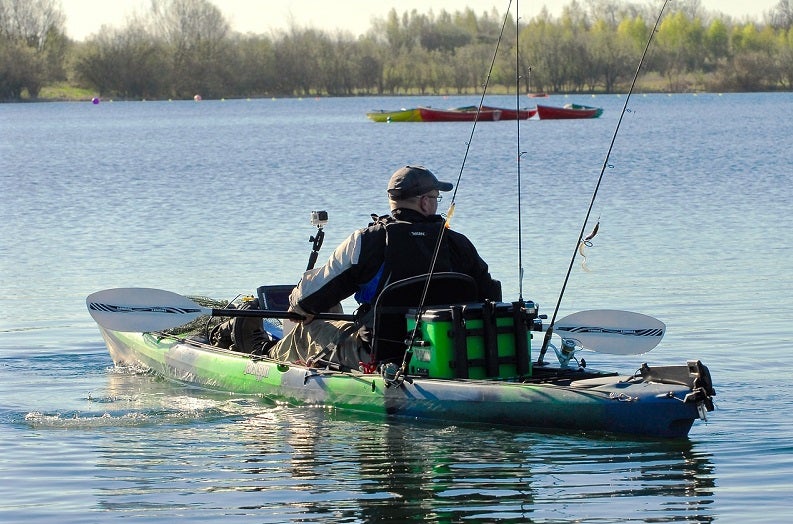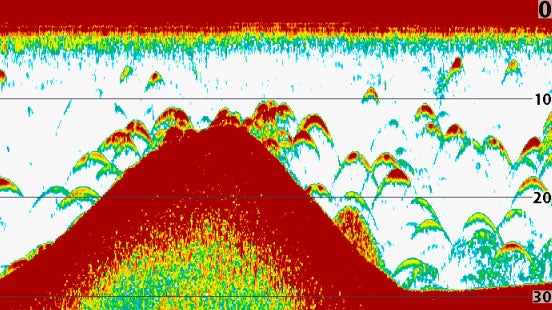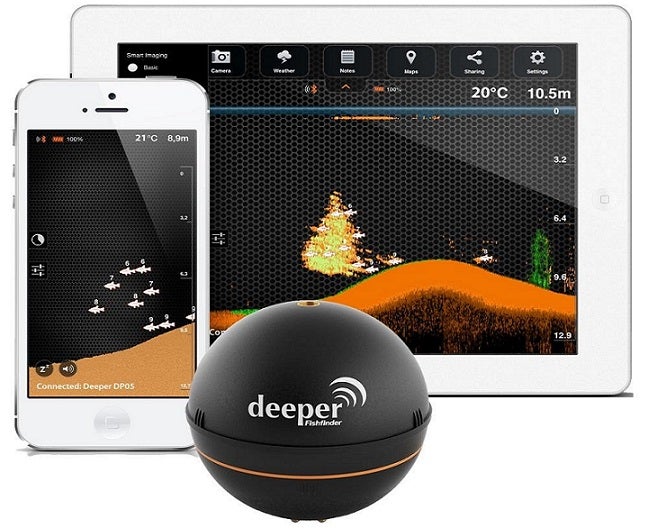
Our Editors independently research, test, and rate what we feel are the best products. We use affiliate links and may receive a small commission on purchases.
Having the best kayak fish finder will help increase the odds of you finding and catching fish. Using a portable, wireless fish finder will make your day on the water that much more enjoyable.
With so many fish finders on the market how do you know which one to buy?
There are many models to choose from with various features. To make it easy for you we tested 9 of the top models on the market based on range, screen resolution, battery life and features.
For more of my kayak gear recommendations, have a look through these popular Outside Pursuits guide links: Fishing Kayaks, Kayak Paddles, Life Jackets
Quick Answer: The 5 Best Rated Kayak Fish Finders For 2021
- Deeper Smart Portable Fish Finder
- NorCross HawkEye F33P Fish Finder
- iBobber Wireless Bluetooth Smart Fish Finder
- Garmin Striker 4 Portable Fish Finder
- LUCKY Portable Fish Finder
Our guide and comparison table of the top rated kayak fish finders will help you choose the right one for you.
Kayak Fish Finder Reviews
#1 Deeper Smart Portable Fish Finder
- Max Depth: 260 Feet
- Compatible with iOS and Android devices
- Use for: Ice, kayak, shore fishing
- Dual frequency fish finder
The Deeper Smart Portable Fish Finder uses WiFi technology to transfer sonar readings right to your device from up to 150 feet away. The device doesn’t require cellular data, in order to make the sonar operable. As a result, it can be used anywhere.
The device is a dual frequency sonar that allows you to cover both wide and narrow area, which accounts for both ample searching facility as well as providing high frequency returns.
The smart sonar functions in the depths from 1.5 feet (0.5 meter) to 120 feet (40 meters), in both fresh and salt water.
It also gives you more features than most traditional sonars that are available on the market. You get information about fish, bottom contour, structure, depth as well as water temperature and even more.
The tennis ball size device is highly mobile with weighing only 3.5 Ounces (100 grams) and 2.5 inches in diameter (65mm), making it convenient to mount anywhere on your kayak as well.
The Deeper Wireless Sonar Smart Fish Finder is an ultimate choice for a compact and lightweight smart sonar and the perfect choice for a kayak fisherman.
The ability to be used on the shore, dock, bridge or kayak is an added bonus that comes with Deeper Wireless Sonar Smart Fish Finder. The device does not require any installation, or contain any wires or external batteries, adding to the convenience.
It works in conjunction with smart phones as well as tablets. It’s compatible with the Apple iPhone as well as Android devices. Bluetooth connectivity makes data transfers ever so smooth. The battery is a rechargeable and it lasts up to 4 hours.
The smart device is pre-loaded with a free application that includes fish activity calendar, weather details, diary, maps, as well as sharing functions. The up-to-date weather reports make sure that you don’t run into any unexpected storms.
The additional import and export functions allows you to use multiple devices and keep all the data in the cloud.
The app allows your smartphone or tablet would be turned into a powerful and professional sonar display. If your looking for the best kayak fish finder, the Deeper is for you!
#2 HawkEye Fishtrax 1C Fish Finder
- Max Depth: 100 Feet
- Compatible with iOS and Android devices
- Palm sized, fits in your tackle box
This ideal tool for fishermen uses an ultra-wide, 25 degree sonar beam angle, delivering accurate depth, fish and bottom structure readings from 1.5 to 99.9 feet. Its operates down to zero degrees Fahrenheit, so the device can be used any time of year.
The NorCross HawkEye F33P Fish Finder includes a troll able, mountable as well as floatable sonar sensor, that comes with a 35 feet of cable and cable tie-strap, making mounting it on your kayak extremely convenient.
Its a user friendly device, all you have to do is to turn the power on, toss the sonar sensor from the shoreline, bridge or the boat, to get your accurate readings. It’s small enough to fit in your palm of your hand.
The device is an ideal choice for all fishing expeditions. The Hawkeye f33P offers the latest in portable fishing finder technology with a weight of only 1.5 pounds and is guaranteed to help you find where the fish are with a 45 degree sonar beam angle.
The NorCross HawkEye Fish Finder comes with its Side Scan adapter, which allows the device to be attached to a broomstick handle in order to scan under weeds, lily pads, ice or even docks.
The manufacturer was thoughtful enough to include installation tabs for hull mounting of the device, which makes it a perfect companion for canoes, kayaks, and even Jon boats.
The NorCross HawkEye Fish Finder uses an advanced algorithmic programming that helps it compute accurate readings.
The fish identifier, depth scale as well as two stage audible fish alarm makes sure that you’ll always know exactly what kind of fishing you’re observing.
The device’s antenna is powered by four “AAA” batteries, providing 20 hours of continuous use, giving you ample time to catch your limit.
The NorCross Hawkeye is the best cheap fish finder on the market.
#3 ReelSonar iBobber Smart Fish Finder
- Max Depth: 135 Feet
- Bluetooth casting range is 100 ft
- Waterbed and structure contour mapping
- Lunar calendar and weather (temp, rain, wind, barometer)
- Fish & strike alarms
- 10+ hrs battery life
- GPS spot tagging with interactive map
- LED beacon for night use
The ReelSonar is one of the best and easiest to use portable fish finders there is. It has a small transducer that transmits data to your smart device (iOS and Android) using Bluetooth Smart 4.0 at a range of 100 feet (33 meters).
It also works with the iWatch and Google watch. With the ReelSonar you can map the waterbed contours and for structures like ledges, drop offs and holes where the fish like to hide.
It works equally well in fresh water or salt water and can even be used for ice and night fishing. The iBobber personal fish finder is a great tool for fishing whether you like to fish from a kayak, shore or a dock.
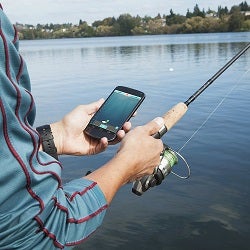
If you are night fishing or ice fishing the iBobber is ideal because you can set an alarm by LED or sound for when the fish are near or biting.
The iBobber is used through a free downloadable app that uses a high contrast display for good visibility in bright sun and also has an anti-glare setting if you are having trouble reading the display.
The transducer is light and small enough to be castable with standard fishing line and has up to a 100 range.
The iBobber allows you to mark spots with GPS that look interesting or where you find fish. You have two fish settings: one for fish over 15 inches and one for fish under 15 inches.
I think the best way to use it is by trolling it behind your kayak. Set the alarm so that you don’t have to watch the display. It will alert you to the fish. This is such a great feature IMO.
What is so nice about using a fish finder is not just the fact it will tell you where the fish are but just as importantly is where the fish ARE NOT.
So you don’t waste time fishing where they aren’t. My fishing success has gone up dramatically since using the ReelSonar.
The iBobber has pretty solid battery life at 10 hours and uses a rechargeable battery so you don’t need to waste money with disposable batteries. It has a useful mapping and fish finding depth of 135 feet.
For a bargain price I think the iBobber is the best castable fish finder on the market.
#4 Garmin Striker 4 with Portable Kit
- 3.5-inch color display fish finder with built-in GPS for creating waypoints
- Includes a portable carrying case for kayak, canoe or ice fishing
- Uses Garmin’s CHIRP (77/200 kHz) sonar transducer
- Waterbed and structure contour mapping
Garmin is best known for the their GPS but they also make a solid fish finder. The Garmin Striker 4 uses Garmin proprietary “CHIRP” Compressed High-Intensity Radiated Pulse technology.
Without getting into too many specifics, what it is in a nutshell is the Garmin Stryker 4 transmits multiple frequencies of sonar.
This is important because unlike single frequency sonar, using a continuous sweep of frequencies between (77/200 kHz) gives you a MUCH clearer and detailed picture of whats below. Especially important when the water temperature changes a lot with depth.
There is also an option upgrade that uses an even greater frequency range that will give you crystal clear images of the terrain below.
The Garmin Stryker as you would expect has a built in GPS that allows you to mark waypoints to map good fishing spots that are around underwater structures like ledges, stumps and drop offs.
While not as important on a kayak or especially from shore the Striker has your speed displayed on the screen to make sure if your trolling, that you are at the right speed for the lure you are using.
Unlike several of the other portable fish finders I have reviewed, the Striker is a self contained unit that does not use a smart device. The Srtiker is available in in 3.5, 5 and 7-inch display sizes that give you a clear color display.
Navigation between all the features is done through the use of just few buttons on the unit. The portable kit includes a sealed, water tight rechargeable battery, a cable management system and a transducer mount with a suction cup, perfect for kayak or canoe.
Overall the Garmin Stryker is an excellent choice and with Garmin’s reputation, I think this is the best kayak GPS.
#5 LUCKY Portable Fish Finder
- Max Depth: 26 Feet
- 3 underwater color display settings
- Fish alarms
- Rechargeable
This portable fish finder is a great option for those of you on a budget. The LUCKY Portable Fish Finder provides you with 26 feet of wires that has the capacity to register depths of up to 328 feet. It also boasts a 2.9 inch LDC screen where it displays information such as underwater contour, water depth, water temperature and fish size and fish depth.
The design is lightweight at 400 grams, as well as compact and slim, easily fitting into the palm of your hand. These dimensions make it an ideal handheld option, it isn’t capable of showing fish on your smartphone or tablet however.
The LUCKY Fish Finder has a level 4 waterproof rating and can be used for river, sea or ice fishing.
The device is rechargeable and includes a USB charging cable. Off of a full charge, the battery can last approximately five hours.
This fish hunter has a respectible 200 KHz transducer which provides accuracy and detail to easily find where the fish are.
All things considered, the LUCKY portable fish finder is a great handheld option for a kayak fish finder.
Kayak Fish Finder Comparison Table
| Fish Finder | GPS | Max Depth | Battery Life | Sync Range | Rating | |
|---|---|---|---|---|---|---|
| Deeper Smart Portable Fish Finder | No | 260 feet | 6 hours | 150 ft | 3.7 / 5.0 | |
| NorCross HawkEye F33P | No | 100 feet | 20 hours | N/A | 4.1 / 5.0 | |
| ReelSonar iBobber Smart Fish Finder | Yes | 135 feet | 10+ hours | 100 ft | 3.2 / 5.0 | |
| Garmin Striker 4 | Yes | 1,600 ft | 50 hours | N/A | 4.6 / 5.0 | |
| LUCKY Portable Fish Finder | No | 328 feet | 5 hours | N/A | 4.2 / 5.0 |
How to Choose the Best Kayak Fish Finder – Buyers Guide
- Frequencies
- Power
- Screen Resolution
- Transducers
- Cone Angles and Beams
- Battery Life
- Smartphone Bluetooth Compatibility
- Fish Finder Comparison
Frequencies
The Frequencies that the fish finder uses are probably the most important factor when you choose your kayak fish finder as it will determine the fish finders effective depth at finding fish and its cone angle(width it will find fish, see below).
Higher frequencies like 192.200 kHz work best in shallower water, whilst the 50 kHz transducers work best for use in deep water for both commercial and professional use. It’s important to keep in mind that the higher the frequency, the more detail shows up on the screen.
It’s due to the fact that there are ample sonar waves that are sent out and received by the transducer. If your fishing in shallow waters, the lower frequencies would work fine.
Whereas in deep waters when the precision is really needed, you need to go with a fish finder that has high frequency capability.
There are fish finders that are capable of sending out multiple 400+ kHz frequencies, which translates into widely detailed images which allows you to switch between them for broader and more precise and accurate views.
Power
A very crucial factor to consider before purchasing a kayak fish finder is the power output. The power of fish finder equipment is measured in wattage. The greater the wattage, the faster your fish finder can display readings, which are deeper under water it will reach.
Likewise, the lesser the wattage, the slower it will be, and suited more for shallower waters. It’s because of the fact that the fish finder receives and translates the sonar waves it receives from the transducer.
If the overall power is less, the sonar waves will be weaker and would ultimately lead to fuzzier readings. Greater power translates into stronger waves and much clearer and detailed readings.
So in a nutshell, a less powerful fish finder is suitable for shallower waters, whilst deep water such as lake or a salt water body will require a higher wattage piece of equipment.
At 50 kHz, for every 100 watts of power, the finder or transducer of your choice could show readings up to 400 feet at 200 kHz, for every 100 watts of power, your fish finder will show readings up to 100 feet.
However, as most mid-range finders are dual frequency enabled, you can see the readings from both frequencies in a split screen.
Screen Resolution
Screen resolution denotes the amount of pixels your fish finder’s screen displays. A factor that’s crucial for the productivity of your kayak fish finder is the screen resolution.
Resolution refers to the pixels or dots on the screen, which contain the smallest amount of detail. The collection of individual pixels together would form the ultimate picture that you get to see on the screen.
The greater the number of pixels is, the more detail you get. The minimum you want a screen to show would be 240 x 160 pixels, which means there are 240 pixels (dots) in horizontal lines, and 160 dots in vertical lines.
The screen resolution would be the ultimate factor for how clear and precise your display is, when combined with screen size.
It’s important to invest in a fish finder tool that packs a higher resolution screen. The ones with smaller screens are ideal as back up fish finders, whilst the main one of your choice should be one that comes with a bigger and more detailed screen.
Transducers
When you purchase your kayak fish finder, it’s important to keep in mind that the transducers are critical to its usefulness. The transducer is what emits and receives the sonar waves.
The transducers send the sonar signal into the water and they bounce off objects underwater to be received by the transducer.
Most of the modern day fish finder units come with transom mount transducers that require very little installation, which makes their installation easy.
With the more expensive and advanced types come with a ‘thru-hull’ type of transducer makes for the easiest of installations.
Cone Angles and Beams
Before you purchase your kayak fish finder, make sure that you pay close attention to the cone angle. It refers to how wide of a beam is sent from the bottom of your boat into the water.
It looks like an upside down ice cream cone, the wider the degree of the cone, the larger the area that’s being covered.
As you go deeper, the cone gets wider. It’s important to know that as the cone angle gets wider, the sensitivity starts to diminish in deeper waters. Transducer cones are available in ranges of 9 degrees to greater than 60 degrees.
However, most units that are available on the market vary between 16 and 20 degrees with a 20 degree cone being a good choice.
Most transducers have more than one cone transmitting from the starting point. The standard transducer will contain a single beam, and as you get more and more advanced, you can progress to a dual beam, triple beam and even side beam and so forth.
Each additional beam helps you cover more and more water, so its an important factor to consider in your choice of a fish finder.
Battery Life
The power source is an important feature when purchasing your kayak fish finder unit as you won’t be having access to power sources while you fish.
It’s important to keep in mind that the battery that comes with the fish finder can make a big difference to its usefulness. The battery can be a standard marine battery, but make sure that it can be packed in a waterproof box or a cover.
You can then run the wires from the battery to the transducer and display. You can even purchase a fish finder that comes with waterproof battery packs built into the case. Others may require a set of third party batteries.
However, keep in mind that you need high quality batteries with a long run life to make sure that they don’t die on you when you really need them.
Smartphone Bluetooth Compatibility
Bluetooth and smartphone compatibility can be a determining factor when picking your fish finder as it gives you the ability to connect your smartphone with your kayak fish finder. That means you can transmit data from your fish finder to your smartphone.
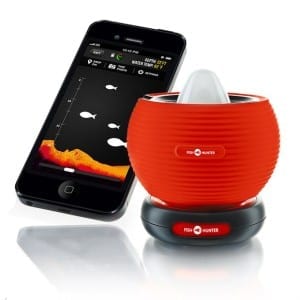
So now you have the ability to keep your data stored on your phone for later access. In addition, the compatibility with smartphones as well as tablets can give you the capability to use them as a display and take advantage of their resolution and in the case of a tablet, a large display.
If you are looking to buy a kayak, see my guide here. I personally prefer an inflatable kayak, it allows me to get to places a standard hard-shell kayak cannot, click here to read my reviews.
I hope this guide was helpful for finding a good kayak fish finder to fit your needs. If you want to comment or recommend a fish finder I didn’t include, please use my contact form to get in touch.
Have fun and good luck!
How We Researched
To come up with the top kayak fish finders, we researched a variety of sources for reviews such as REI, Dicks Sporting Goods, Cabelas and Backcountry along with our own personal experience.
We also consulted online magazines for product research and reviews to get as much unbiased information as we could. To help weed out fake reviews we used Fakespot.com to make sure we only looked at genuine reviews.
With so much quality gear available, we had to narrow it down based on what we felt were the best options for the price. The author, Richard Remick, is an avid kayak paddler and fisherman.
To help narrow down the selection he used his personal experience along with recommendations from fellow kayak fishing enthusiasts.
After extensive research, we came up with our list to help you choose the right one for you.
Sources

